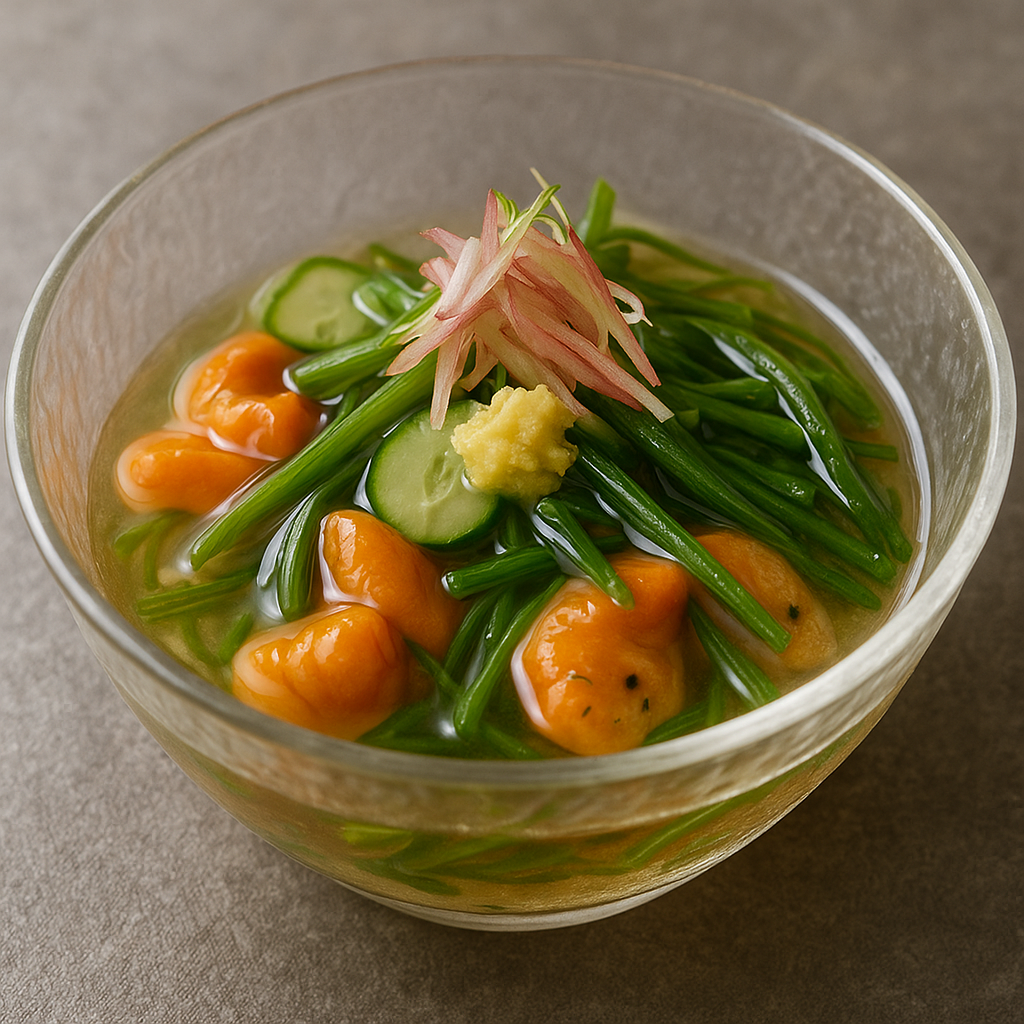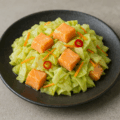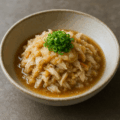ミズとホヤの水物の特徴
山のミズ×海のホヤ、三陸・津軽の夏の酢もの
シャキッとした食感の山菜「ミズ(ウワバミソウ)」に、潮の香り豊かな赤ホヤを合わせた一皿。冷やした三杯酢でさっと和え、きゅうりや薬味を添えて爽やかに仕上げます。
ぬめりとうま味を生かす下処理が鍵
ミズは皮引き→塩もみ→短時間の湯通しで色と歯ざわりをキープ。ホヤは塩水でやさしく洗い、少量の酢で軽く締めることで香りが立ち、雑味が抜けます。
キンと冷やして、後味すっきり
煮切ったみりんを使う三杯酢は角が取れてまろやか。器も冷やしておくと、ひと口ごとに清涼感が増します。
ミズとホヤの水物のレシピ
材料(2〜3人分)
- ミズ(茎)… 120g(4〜5cm長さ・筋取り/皮引き)
- 赤ホヤ … 1個(可食部120〜150g目安)
- きゅうり … 1/2本(薄切り・塩ひとつまみでもみ、軽く水気を切る)
- みょうが … 1個(小口切り)
- 青じそ … 2枚(せん切り)
- 生姜 … 少々(せん切り)
- 塩 … 適量(下処理用)
三杯酢(よく冷やして使用)
- だし … 80ml
- 米酢 … 60ml
- 薄口醤油 … 大さじ1
- みりん … 大さじ1(煮切ってアルコールを飛ばす)
- 砂糖 … 小さじ1/2(好みで)
- 塩 … ひとつまみ
作り方
- ミズの下処理:茎の筋・皮を引き、塩少々でもんで5分置く。さっと洗い、熱湯に10〜20秒だけくぐらせて氷水へ。水気をよく切る(ぬめりは好みで軽く残す)。
- ホヤの下処理:口を切り開けて身を取り出し、黒いワタ・白い結石を除く。食べやすく切り、3%の塩水でやさしく洗って水気を拭く。米酢を小さじ1ほどまぶし、冷蔵で10分置いて軽く締める。
- 三杯酢:みりんを煮切ってから、だし・米酢・薄口醤油・砂糖・塩と合わせ、よく冷やす。
- 和える:ボウルにミズ・ホヤ・きゅうりを入れ、三杯酢を回しかけてさっと和え、10〜15分なじませる。
- 仕上げ:器に盛り、みょうが・青じそ・生姜を添える。よく冷えた状態で供する。
シェフのワンポイントアドバイス
- ミズは火を通しすぎない(色と食感が大事な為)。
- ホヤは真水で強く洗いすぎない(風味が抜けるため)。塩水洗い→短時間の酢で締めが良い。
- 酸味が目立つときはだし・砂糖で微調整、甘いときは酢を少量足してバランス整える。
栄養価(1人分の目安)
- エネルギー:約90〜140 kcal
- たんぱく質:10〜15 g(ホヤ由来)
- 脂質:2〜4 g/炭水化物:6〜12 g
- ミネラル・ヨウ素(ホヤ)/食物繊維(ミズ)
高たんぱくでさっぱり。塩分は三杯酢と下処理の塩加減でコントロールしやすいです。
歴史
山海の出会いが生んだ“夏の酒肴”
山の恵み「ミズ」と海の恵み「ホヤ」が豊富な三陸・津軽で、家庭や居酒屋の定番として親しまれてきた清涼の一品。旬の短い食材同士を生かす知恵が息づいています。
English Version
Features of “Mizu & Hoya” Sunomono
Mountains meet sea: a crisp, cooling summer salad from Sanriku–Tsugaru
Crunchy wild greens mizu (Elatostema) are paired with briny, aromatic red sea squirt (hoya/sea pineapple). Tossed lightly in well-chilled sanbaizu (sweetened vinegar) and served with cucumber and aromatics for a refreshing finish.
Prep that preserves slickness and umami
Mizu keeps its color and bite with peeling → salting → a very brief blanch. Hoya is rinsed gently in salt water and lightly “tightened” with a touch of vinegar to lift aroma and remove off-notes.
Serve well-chilled for a clean aftertaste
Using mirin that’s been boiled to remove alcohol softens edges in the dressing. Chill the bowl and plates so each bite feels extra crisp.
Recipe
Ingredients (2–3 servings)
- Mizu stems … 120 g (4–5 cm lengths; strings/skin removed)
- Red sea squirt (hoya) … 1 piece (about 120–150 g edible)
- Cucumber … 1/2 (thinly sliced; massage with a pinch of salt, then lightly drain)
- Myoga … 1 bud (thinly sliced)
- Shiso … 2 leaves (fine chiffonade)
- Ginger … a little (fine matchsticks)
- Salt … as needed (for prep)
Sanbaizu (chill well before using)
- Dashi … 80 ml
- Rice vinegar … 60 ml
- Light soy sauce … 1 tbsp
- Mirin … 1 tbsp (boil to remove alcohol)
- Sugar … 1/2 tsp (to taste)
- Salt … a pinch
Instructions
- Prep the mizu: Peel strings/skin, massage lightly with a little salt and rest 5 min. Rinse, then blanch in boiling water for 10–20 seconds and shock in ice water. Drain very well (leave a touch of natural slickness if you like).
- Prep the hoya: Open the siphon end, remove the meat, discard the dark innards and white calcareous pieces. Cut into bite-size pieces, rinse gently in 3% salt water, pat dry, then toss with about 1 tsp rice vinegar and chill 10 min to firm.
- Make the sanbaizu: After boiling off alcohol from mirin, combine with dashi, rice vinegar, light soy, sugar, and salt. Chill thoroughly.
- Toss: In a bowl, combine mizu, hoya, and cucumber. Add sanbaizu and toss briefly; let stand 10–15 minutes to marry.
- Finish: Plate and top with myoga, shiso, and ginger. Serve well-chilled.
Chef’s Tips
- Do not overcook mizu—its vivid green and snap are essential.
- Avoid vigorous rinsing in plain water for hoya; use salt water, then a short vinegar tighten to preserve flavor.
- If acidity dominates, round it with a touch more dashi or sugar; if too sweet, add a splash of vinegar.
- Best eaten the day it’s made (hoya aroma changes over time).
Nutritional Value (per person, approx.)
- Calories: ~90–140 kcal
- Protein: 10–15 g (from hoya)
- Fat: 2–4 g / Carbohydrates: 6–12 g
- Minerals & iodine (hoya) / dietary fiber (mizu)
History
A summer drinking dish born of mountain–sea abundance
In Sanriku and Tsugaru—rich in both mountain greens and seafood—this chilled vinegar dish became a household and tavern staple, making the most of two short-season ingredients at their peak.



何でも質問してください!